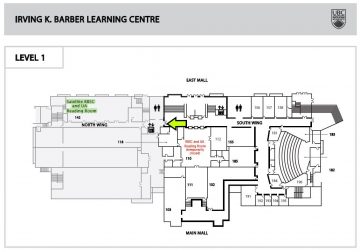The early to mid 1900s marked a time of immense social exclusion for immigrants and people of colour in Vancouver, with most white-run businesses catering solely to Anglo customers. Much of the studio photography that has emerged from this era reflects this reality, obscuring the existence of the city’s immigrant families in the process. However, Yucho Chow, Vancouver’s first Chinese photographer, welcomed everyone into his studio. His works not only elucidate Vancouver’s 20th-century diversity, but provide families otherwise excluded from portrait photography with visual documentation of their histories, too.

Portrait of Chinese family, after 1920 (Uno Langmann Collection)
Yucho Chow opened his Vancouver photography studio in 1907. In alignment with his slogan “Rain or Shine, Anything, Anywhere, Anytime”, Chow photographed anyone who asked. Thus, his customer base largely comprised of those who had historically been denied service by Vancouver’s Anglo photographers, including Punjabi Sikh, Black, Japanese, Indigenous, Ukrainian, and Czech communities.

Yucho Chow Studio envelope, circa 1930s (Uno Langmann Collection)
In 2011, community historian Catherine Clement partnered with the Chinese Canadian Historical Society of British Columbia to bring together the works of Yucho Chow, most of which were at that time housed in private family photo albums. By unravelling Chow’s story, Clement found that she consequently unravelled a myriad of others, bringing to light the lives of other Vancouver immigrants. These photographs are digitally browsable through the project’s website, as well as the City of Vancouver Archives.

Young person and infant, circa 1930s (Uno Langmann Collection)
In Part 1 of our two-part series about Yucho Chow, we explore his path to becoming one of Vancouver’s most revered chroniclers of 20th-century communities of colour. The Wallace B. Chung and Madeline H. Chung Collection and the Uno Langmann Family Collection of B.C. Photographs, both available to browse through UBC Open Collections, feature an array of Yucho Chow’s work, including a remarkable album containing studio portraits and ephemera from his business operations.
Chow’s beginnings
Yucho Chow was born in 1876 in Kaiping, China. In 1902, he immigrated to Canada, where he was forced to pay the Chinese head tax, a shameful, racist legislative policy imposed upon Chinese immigrants by the Canadian government from 1885 to 1923. Little is known about Chow’s life in Vancouver before he opened his studio in 1907, though it is rumoured he worked as a house servant while apprenticing to become a photographer.
Chow opened the Yucho Chow Studio at 68 West Hastings St. in 1907 during a time of widespread and deeply oppressive anti-Asian discrimination in Canada. This was reflected in social attitudes as well as legislation, impacting Asian residents’ access to employment, education, housing. The grand opening of Yucho Chow Studio occurred only a short time before the Vancouver anti-Asian Chinatown riots of 1907. Still, Chow continued to run his successful and well-loved business for 42 years until his passing in 1949.

A group portrait with Yucho Chow at front centre, circa 1930s (Uno Langmann Collection)
Chow’s subjects
Chow invited all customers to be photographed in his studio. Here, he took portraits of newlyweds, families, babies, and even the recently deceased, providing families with photos to send back home as “informal death certificates”. He also documented these communities outside his studio, capturing everyday moments as well as organized events like celebrations, graduations, and clan gatherings.

Strathcona Elementary School kindergarten class portrait, after 1920 (Chung Collection)
Even more progressive than his embrace of customers of all races and nationalities was Chow’s openness to photographing interracial marriages, which were deemed widely unacceptable across many social and cultural lines.

Advertisement in City of Vancouver Police Department Publication, 1921 (BC Historical Books Collection)
For marginalized Vancouver residents who experienced daily exclusion in so many other social domains, it wasn’t just Chow’s chronicling of their histories that was impactful, but his inclusivity, too.

Quon On Jan Travel Agency,1915 (Chung Collection)
Stay tuned…
… For Part 2, where we explore Chow’s style, techniques, and legacy.
Learn more
Through a Wide Lens – The Hidden Photographs of Yucho Chow (video by Catherine Clement & the Vancouver Historical Society, 2020)
Yucho Chow’s Vancouver (photo essay, The Tyee, 2019)
References
Cheung, C. (2020, December 29). How Yucho Chow’s photos reframed Vancouver history. The Tyee. https://thetyee.ca/Culture/2020/12/29/Yucho-Chow-Photos-Reframe-Vancouver/
Chinatown through a wide lens: The hidden photographs of Yucho Chow. (n.d.). Yucho Chow. https://www.yuchochow.ca/
Griffin, K. (2019, May 3). ‘Silent’ Yucho Chow photograph has a story again after being identified by family. Vancouver Sun. https://vancouversun.com/news/local-news/silent-yucho-chow-photograph-has-a-story-again-after-being-identified-by-family
Peng, J. (2023). Yucho Chow. In The Canadian Encyclopedia. Historica Canada. https://www.thecanadianencyclopedia.ca/en/article/yucho-chow
Yucho Chow. (2025 August 5). In Wikipedia. https://en.wikipedia.org/wiki/Yucho_Chow












